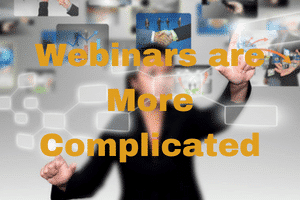One of the most common questions that we receive in our public speaking classes is, “Do the things that you are teaching us about in-person presentations change when you are on a webinar or an online platform?” The answer to that question is both “Yes” and “No”.

The way that we teach people to design presentations is based on the following. First, we focus on the audience and what the audience wants and needs to know. Second, you have to make your content concise and entertaining. So, in those respects, yes, digital meeting creation is pretty much the same as an in-person presentation. However, there are seven important things that you need to know about online meetings that make them dramatically different. If you understand these things, you can create powerful online presentations that leverage your time and reach.
This is article and podcast is part one of a three-part series. Part two will be about how to customize your content for digital delivery. The final part is about the technical aspects of conducting a live meeting. In part three, I’ll show you the software that I use and why I use it.
7 Important Things that You Need to Know about Online Live Meetings (Like Zoom or Skype)
1) Online Meetings are a Fast and Easy Way to Deliver Bite-Sized Pieces of Content to an Audience.
“Bite-size training achieves quicker outcomes without blowing the budget.” — Dr. Sebastian Baily, Co-Founder of Mind Gym.
 When I started teaching classes, my first coach was a guy named Jim Bartz in Dallas. Jim used to harp on me over and over about the value of what he called “time-spaced learning”. He discovered that course participants learn quickly and to retain the information if you do the following. First, teach them a concept and make the delivery interactive. Then give the class members time to apply the content in the “real world”.
When I started teaching classes, my first coach was a guy named Jim Bartz in Dallas. Jim used to harp on me over and over about the value of what he called “time-spaced learning”. He discovered that course participants learn quickly and to retain the information if you do the following. First, teach them a concept and make the delivery interactive. Then give the class members time to apply the content in the “real world”.
His concept was to conduct short, half-day sessions of content one-at-a-time on a weekly basis. The strategy worked phenomenally well. In fact, when I designed my first leadership class, I used this technique. I created a series of six, half-day sessions spaced a week apart. By the end of the six-week class, the participants had experienced a dramatic behavior change. They retained the content longer and applied it effectively as well.
When I was just teaching classes in Dallas, it was easy to travel across town six times in six weeks. However, when I began teaching classes in Austin and Houston, those weekly car trips were time-consuming and expensive. As I expanded to other cities, this caused an expensive challenge.
Technology fixed this logistical problem in the last few years, though. With webinars, I (or another instructor) can deliver bite-sized content on a daily, weekly, or monthly basis for little or no cost at all.
2) Online Meetings Can Expand Your Reach Very Quickly.
“Electronic communication makes possible what has previously been excluded: namely, active, simultaneous and reciprocal contact between individuals across all frontiers constituted by countries, religions and continents.” — Ulrich Beck.
 The major benefit of webinars is that anyone who has a smartphone or internet connection can access them. As a result, you have incredible reach in today’s world if you use webinars.
The major benefit of webinars is that anyone who has a smartphone or internet connection can access them. As a result, you have incredible reach in today’s world if you use webinars.
If you are an entrepreneur, you can generate webinar attendees by posting an invitation to your website and social media accounts. By doing this, you can reach potential customers all over the world. I’ve had people fly to the United States or into our classes in Europe from all over the world as a result of these people attending webinars that we have conducted. With Zoom, Facebook, and LinkedIn Live, now, that is likely to increase in the future.
If you are creating webinars for an internal audience, you can communicate with employees in multiple cities, states, or countries all at the same time. We do this internally with The Leader’s Institute ®. I have dozens of instructors all over the US, Canada, and Europe, so we will meet every week via Zoom to share success stories, cover training topics, and exchange ideas that would be very difficult to do logistically without online meeting platforms.
3) Online Meetings are Not Suitable to Every Type of Presentation.
 Yes, there are a LOT of advantages to digital meetings, but there are also a lot of extremely important disadvantages as well. The main disadvantage is that webinars are not the best medium for certain types of skill-based programs. For instance, I don’t think it would be a great idea to teach a teenager how to drive via an online meeting. That is a skill that takes practice.
Yes, there are a LOT of advantages to digital meetings, but there are also a lot of extremely important disadvantages as well. The main disadvantage is that webinars are not the best medium for certain types of skill-based programs. For instance, I don’t think it would be a great idea to teach a teenager how to drive via an online meeting. That is a skill that takes practice.
However, one of the great things about Zoom is that technology is now allowing for the coaching of groups digitally. In the past, we have done a lot of coaching via Skype or Facetime, but it was mostly just one-on-one with an instructor. Yes, the training is great in a session like that. However, the person doesn’t really get practice speaking to a group.
That is until Zoom improved noise reduction and create breakout rooms. We have recently begun to offer virtual versions of our Fearless Presentations ® class, and we are getting fantastic results. (Details of this virtual presentation class.)
4) Online Sessions Need to be SHORT in Duration.

The study didn’t address why the people viewing the recording dropped off. I can make a pretty educated guess, though. People are busy. If they are watching a recording, and they see that there is forty minutes left, they will begin to assess whether the first 20 minutes was worth their time. If the answer is no, they will drop off. Also, if they are attending live, they realize they will likely have a chance to ask questions at the end. Without that additional nugget, they often leave the webinar before the recording is finished.
However, if you are concise in your delivery and you can keep your webinar length to 30 minutes or so, this won’t happen as much. Human nature is that once they get to that critical 20-minute point, they will look at the toolbar and see that only ten minutes are left. As a result, they are more likely to finish the entire session.
By the way, for in-person sessions, an hour to an hour-and-fifteen-minutes is the optimal time for a presentation.
5) Digital Meetings are Much Harder to Deliver than In-Person Presentations.
 If you are nervous speaking to groups of people, then you may not want to cut your teeth on digital meetings. Online presentations are dramatically more difficult to deliver than regular live presentations. You are likely to be exponentially more nervous conducting one than you would be just standing up and speaking at a staff meeting in your office.
If you are nervous speaking to groups of people, then you may not want to cut your teeth on digital meetings. Online presentations are dramatically more difficult to deliver than regular live presentations. You are likely to be exponentially more nervous conducting one than you would be just standing up and speaking at a staff meeting in your office.
First of all, you have more balls to juggle. In a regular presentation, you might have to set up a slideshow. But once that is done, you don’t have to worry a lot about the technology involved in your presentation. In a digital meeting, though, you will have the webinar software to worry about. You’ll have to remember to turn off the auto-mute button that many webinar platforms have installed. (I once did 25 minutes of a webinar where I was on a roll covering all kinds of great content, but no one heard any of it because I had “mute” on the whole time.)
You will have people chatting questions to you. You will inevitably have someone log on without headphones, and the feedback will make you have to mute all attendees.
All of these things are stressful challenges that are unique to webinar delivery. The absolute worst part of conducting a webinar, though, is that…
6) It Is Much More Difficult to Get Participants to Interact with You.
 One of the things that our instructors reinforce in our 2-day Fearless Presentations ® classes is that one of the best ways to reduce public speaking fear is to “look for the friendly faces” in your audience. Most often, when you are communicating well in front of a group, you can look around the room and notice people nodding at you when they agree with you. If you say something funny, they will smile. However, on a digital meeting, this important feedback loop is lessened. As a result, the nervousness of the speaker can increase as the session goes on versus decreasing like is common when we speak in person.
One of the things that our instructors reinforce in our 2-day Fearless Presentations ® classes is that one of the best ways to reduce public speaking fear is to “look for the friendly faces” in your audience. Most often, when you are communicating well in front of a group, you can look around the room and notice people nodding at you when they agree with you. If you say something funny, they will smile. However, on a digital meeting, this important feedback loop is lessened. As a result, the nervousness of the speaker can increase as the session goes on versus decreasing like is common when we speak in person.
Next week, I will cover a few fool-proof tips to reducing some of this common tension and making your Zoom Meetings more interactive.
7) Once You Get Good at Digital Meeting and Webinars, Though, You Will be Viewed as an Expert in Your Field.
Although webinars are tougher to get the hang of, and they can make nervous speakers even more nervous, they create a tremendous opportunity in the business world. When I’m teaching the Fearless Presentations ® class, I often tell my class members that if they want to be great speakers, the bar is set pretty low. You don’t have to be an exceptional speaker to be seen as good or even great by your audience. You just have to be a little better than the last speaker who put everyone to sleep, and your audience will love you. So, when people complete my classes, they are often extremely comfortable in front of a group because they know they are more highly trained than most people who speak in business.
In the webinar genre, the contrast is even greater. I spoke earlier about the study where many webinar viewers of the recordings drop off after 20 minutes. It is quite possible that another reason that they drop off is the webinars were just flat terrible. So, if you are interesting as a webinar leader, you have the opportunity to build a following of viewers who see you as the go-to expert in your field by using this technique.
So, now that we have covered a lot of the pros and cons of webinars, next week, we’re going to show you how to create your content for a webinar so that your audience really loves you!
